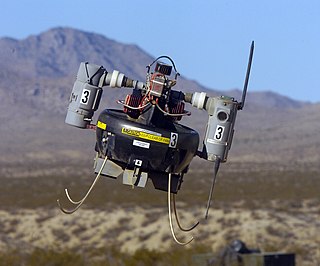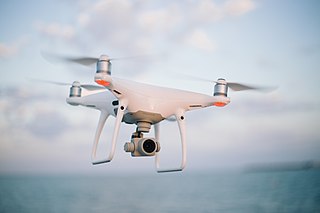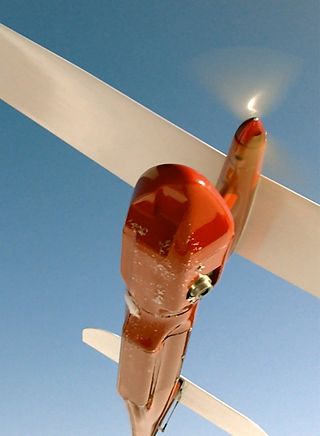
An unmanned aerial vehicle (UAV), commonly known as a drone, is an aircraft without any human pilot, crew, or passengers on board. UAVs were originally developed through the twentieth century for military missions too "dull, dirty or dangerous" for humans, and by the twenty-first, they had become essential assets to most militaries. As control technologies improved and costs fell, their use expanded to many non-military applications. These include aerial photography, area coverage, precision agriculture, forest fire monitoring, river monitoring, environmental monitoring, policing and surveillance, infrastructure inspections, smuggling, product deliveries, entertainment, and drone racing.

A micro air vehicle (MAV), or micro aerial vehicle, is a class of man-portable miniature UAVs whose size enables them to be used in low-altitude, close-in support operations. Modern MAVs can be as small as 5 centimeters - compare Nano Air Vehicle. Development is driven by commercial, research, government, and military organizations; with insect-sized aircraft reportedly expected in the future. The small craft allow remote observation of hazardous environments or of areas inaccessible to ground vehicles. Hobbyists have designed MAVs for applications such as aerial robotics contests and aerial photography. MAVs can offer autonomous modes of flight.

Swarm robotics is an approach to the coordination of multiple robots as a system which consist of large numbers of mostly simple physical robots. ″In a robot swarm, the collective behavior of the robots results from local interactions between the robots and between the robots and the environment in which they act.″ It is supposed that a desired collective behavior emerges from the interactions between the robots and interactions of robots with the environment. This approach emerged on the field of artificial swarm intelligence, as well as the biological studies of insects, ants and other fields in nature, where swarm behaviour occurs.

A miniature UAV, small UAV (SUAV), or drone is an unmanned aerial vehicle small enough to be man-portable. Smallest UAVs are called micro air vehicle.

A quadcopter, also called quadrocopter, or quadrotor is a type of helicopter or multicopter that has four rotors.

The Prioria Robotics Maveric is a discontinued unmanned aerial vehicle (UAV) marketed as a high-performance, next-generation platform for small and miniature UAV operations. Maveric's bendable wings allow for the ability to store a fully assembled airframe in a 6-inch (150 mm) tube.
The Parrot AR.Drone is a discontinued remote-controlled flying quadcopter, built by the French company Parrot.

Pteryx UAV was a Polish Miniature Unmanned Aerial Vehicle (UAV) designed for civilian use. It was manufactured and sold by Trigger Composites. The machine was both a flying remote control (RC) model and pre-programmed vehicle. It was awarded the Innowator Podkarpacia medal for innovative design in the category of micro-enterprises of the Podkarpacie region in 2010.
ZALA Aero Group is a Russian company specialising in unmanned aerial vehicle (UAV) development, located in Izhevsk, Russia. ZALA Aero has provided UAV systems for several sectors of the Russian government, including the Ministry of Defence, and has also won contracts to supply UAVs to foreign countries. The company's in-house design and production projects include a variety of systems related to UAV design, manufacture and operation, including autopilots, airframes, mechanical and pneumatic catapults, launchers, payloads and communication technologies. ZALA Aero is the only Russian company producing unmanned helicopters, portable anti-drone EW systems and a VTOL drone.

A multirotor or multicopter is a rotorcraft with more than two lift-generating rotors. An advantage of multirotor aircraft is the simpler rotor mechanics required for flight control. Unlike single- and double-rotor helicopters which use complex variable pitch rotors whose pitch varies as the blade rotates for flight stability and control, multirotors often use fixed-pitch blades; control of vehicle motion is achieved by varying the relative speed of each rotor to change the thrust and torque produced by each.
Paparazzi is an open-source autopilot system oriented toward inexpensive autonomous aircraft. Low cost and availability enable hobbyist use in small remotely piloted aircraft. The project began in 2003, and is being further developed and used at École nationale de l'aviation civile (ENAC), a French civil aeronautics academy. Several vendors are currently producing Paparazzi autopilots and accessories.

CATUAV S.L. is a technology-based private company that offers aerial services using unmanned aerial vehicles (UAV). Its headquarters are located in the Moià airfield in the BCN Drone Center, 40 km north of Barcelona, Spain.
ArduPilot is an open source, uncrewed vehicle Autopilot Software Suite, capable of controlling:

Yuneec International, established in 1999 in Hong Kong, China, is wholly owned by ATL Global Holding AG of Switzerland. The company has a research and development center headquartered in Zurich, Switzerland, a global market and marketing headquarters in Kaltenkirchen, Germany, and an OEM factory in Kunshan, Jiangsu, China. Initially focused on manufacturing electric remote-controlled model airplanes, Yuneec introduced human-crewed aircraft to the U.S. market through GreenWing International. The company's Yuneec International E430 was the first electric human-crewed aircraft designed for commercial production. Since 2012, Yuneec has concentrated on developing and producing unmanned aerial vehicles (UAVs). By the end of 2016, the company had established a new R&D center, Advanced Technology Labs Ltd, near Zurich, Switzerland, and had begun its global expansion.

A delivery drone is a unmanned aerial vehicle (UAV) designed to transport items such as packages, medicines, foods, postal mails, and other light goods. Large corporations like Amazon, DHL and FedEx have started to use drone delivery services. Drones were used effectively in the fight against COVID-19, delivering millions of vaccines and medical supplies across the globe. Drone deliveries are highly efficient, significantly speeding up delivery times and avoiding challenges traditional delivery vehicles may encounter. Given their life-saving potential use cases for medical supplies in particular have become the most widely-tested type of drone delivery, with trials and pilot projects in dozens of countries such as Australia, Canada, Botswana, Ghana, Uganda, the UK, the US among others.
Unmanned aircraft system simulation focuses on training pilots to control an unmanned aircraft or its payload from a control station. Flight simulation involves a device that artificially re-creates aircraft flight and the environment in which it flies for pilot training, design, or other purposes. It includes replicating the equations that govern how aircraft fly, how they react to applications of flight controls, the effects of other aircraft systems, and how the aircraft reacts to external factors such as air density, turbulence, wind shear, cloud, precipitation, etc.
An autonomous aircraft is an aircraft which flies under the control of automatic systems and needs no intervention from a human pilot. Most autonomous aircraft are unmanned aerial vehicle or drones. However, autonomous control systems are reaching a point where several air taxis and associated regulatory regimes are being developed.












